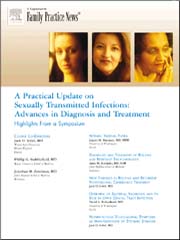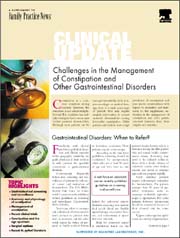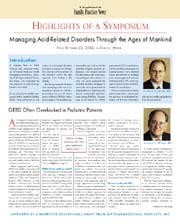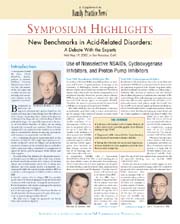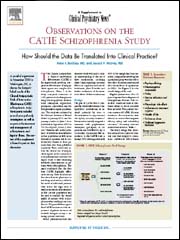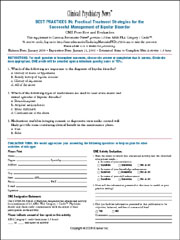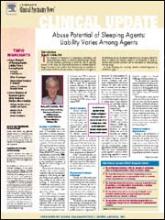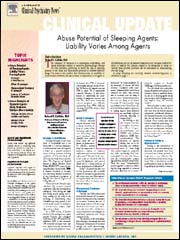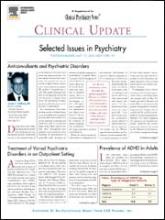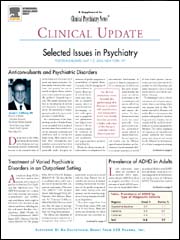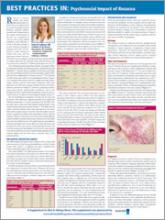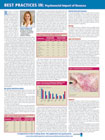User login
A Practical Update on Sexually Transmitted Infections: Advances in Diagnosis and Treatment
A supplement to Family Practice News.
Supported by a restricted educational grant from 3M Pharmaceuticals.
Highlights of presentations that took place at a continuing medical education conference held April 5-6, 2003, Washington, DC.
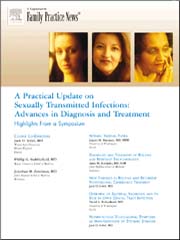
To view the supplement, click the image above.
Contents/Faculty Disclosure
Introduction
Jack D. Sobel, MD
Professor, Chief
Division of Infectious Disease
Wayne State University School of Medicine
Harper Hospital
Detroit, MI
Clinical Grants: 3M Pharmaceuticals, Pfizer, and Ortho-McNeil. Discusses the investigational use of fluconazole and 17.4% topical flucytosine cream for treating Candida glabrata, and 10% hydrocortisone for treating erosive lichen planus.
Phillip G. Stubblefield, MD
Professor and Chairman, Obstetrics and Gynecology
Boston University School of Medicine
Director, Obstetrics and Gynecology
Boston Medical Center
Boston, MA
Nothing to disclose.
Jonathan M. Zenilman, MD
Professor, Infectious Diseases Division
Johns Hopkins School of Medicine
Baltimore, MD
Clinical Grants/Research: Osmetech PLC; Consultant: Merck and Company; Speaker's Bureau: GlaxoSmithKline, Pfizer, Inc.
Normal Vaginal Flora
Jeanne M. Marrazzo, MD, MPH
Assistant Professor, Department of Medicine
Division of Allergy and Infectious Diseases
University of Washington, Harborview Medical Center
Seattle, WA
Discusses the use of intravaginal Lactobacillus crispatus capsules for the treatment of bacterial vaginosis.
Diagnosis and Treatment of Routine and Resistant Trichomoniasis
Anne M. Rompalo, MD, ScM
Associate Professor, Infectious Diseases Division
Johns Hopkins School of Medicine
Baltimore, MD
Clinical Grants/Research: GlaxoSmithKline; Speaker's Bureau: GlaxoSmithKline, Pfizer, Inc.
New Findings in Routine and Recurrent Vulvovaginal Candidiasis Treatment
Jack D. Sobel, MD
Overview of Bacterial Vaginosis and Its Role in Upper Genital Tract Infection
David A. Eschenbach, MD
Professor and Director, Women's Health
Chair, Department of Obstetrics and Gynecology
University of Washington
Seattle, WA
Consultant: 3M Pharmaceuticals.
Noninfectious Vulvovaginal Symptoms as Manifestations of Systemic Diseases
Jack D. Sobel, MD
Copyright © 2003 by International Medical News Group
A supplement to Family Practice News.
Supported by a restricted educational grant from 3M Pharmaceuticals.
Highlights of presentations that took place at a continuing medical education conference held April 5-6, 2003, Washington, DC.

To view the supplement, click the image above.
Contents/Faculty Disclosure
Introduction
Jack D. Sobel, MD
Professor, Chief
Division of Infectious Disease
Wayne State University School of Medicine
Harper Hospital
Detroit, MI
Clinical Grants: 3M Pharmaceuticals, Pfizer, and Ortho-McNeil. Discusses the investigational use of fluconazole and 17.4% topical flucytosine cream for treating Candida glabrata, and 10% hydrocortisone for treating erosive lichen planus.
Phillip G. Stubblefield, MD
Professor and Chairman, Obstetrics and Gynecology
Boston University School of Medicine
Director, Obstetrics and Gynecology
Boston Medical Center
Boston, MA
Nothing to disclose.
Jonathan M. Zenilman, MD
Professor, Infectious Diseases Division
Johns Hopkins School of Medicine
Baltimore, MD
Clinical Grants/Research: Osmetech PLC; Consultant: Merck and Company; Speaker's Bureau: GlaxoSmithKline, Pfizer, Inc.
Normal Vaginal Flora
Jeanne M. Marrazzo, MD, MPH
Assistant Professor, Department of Medicine
Division of Allergy and Infectious Diseases
University of Washington, Harborview Medical Center
Seattle, WA
Discusses the use of intravaginal Lactobacillus crispatus capsules for the treatment of bacterial vaginosis.
Diagnosis and Treatment of Routine and Resistant Trichomoniasis
Anne M. Rompalo, MD, ScM
Associate Professor, Infectious Diseases Division
Johns Hopkins School of Medicine
Baltimore, MD
Clinical Grants/Research: GlaxoSmithKline; Speaker's Bureau: GlaxoSmithKline, Pfizer, Inc.
New Findings in Routine and Recurrent Vulvovaginal Candidiasis Treatment
Jack D. Sobel, MD
Overview of Bacterial Vaginosis and Its Role in Upper Genital Tract Infection
David A. Eschenbach, MD
Professor and Director, Women's Health
Chair, Department of Obstetrics and Gynecology
University of Washington
Seattle, WA
Consultant: 3M Pharmaceuticals.
Noninfectious Vulvovaginal Symptoms as Manifestations of Systemic Diseases
Jack D. Sobel, MD
Copyright © 2003 by International Medical News Group
A supplement to Family Practice News.
Supported by a restricted educational grant from 3M Pharmaceuticals.
Highlights of presentations that took place at a continuing medical education conference held April 5-6, 2003, Washington, DC.

To view the supplement, click the image above.
Contents/Faculty Disclosure
Introduction
Jack D. Sobel, MD
Professor, Chief
Division of Infectious Disease
Wayne State University School of Medicine
Harper Hospital
Detroit, MI
Clinical Grants: 3M Pharmaceuticals, Pfizer, and Ortho-McNeil. Discusses the investigational use of fluconazole and 17.4% topical flucytosine cream for treating Candida glabrata, and 10% hydrocortisone for treating erosive lichen planus.
Phillip G. Stubblefield, MD
Professor and Chairman, Obstetrics and Gynecology
Boston University School of Medicine
Director, Obstetrics and Gynecology
Boston Medical Center
Boston, MA
Nothing to disclose.
Jonathan M. Zenilman, MD
Professor, Infectious Diseases Division
Johns Hopkins School of Medicine
Baltimore, MD
Clinical Grants/Research: Osmetech PLC; Consultant: Merck and Company; Speaker's Bureau: GlaxoSmithKline, Pfizer, Inc.
Normal Vaginal Flora
Jeanne M. Marrazzo, MD, MPH
Assistant Professor, Department of Medicine
Division of Allergy and Infectious Diseases
University of Washington, Harborview Medical Center
Seattle, WA
Discusses the use of intravaginal Lactobacillus crispatus capsules for the treatment of bacterial vaginosis.
Diagnosis and Treatment of Routine and Resistant Trichomoniasis
Anne M. Rompalo, MD, ScM
Associate Professor, Infectious Diseases Division
Johns Hopkins School of Medicine
Baltimore, MD
Clinical Grants/Research: GlaxoSmithKline; Speaker's Bureau: GlaxoSmithKline, Pfizer, Inc.
New Findings in Routine and Recurrent Vulvovaginal Candidiasis Treatment
Jack D. Sobel, MD
Overview of Bacterial Vaginosis and Its Role in Upper Genital Tract Infection
David A. Eschenbach, MD
Professor and Director, Women's Health
Chair, Department of Obstetrics and Gynecology
University of Washington
Seattle, WA
Consultant: 3M Pharmaceuticals.
Noninfectious Vulvovaginal Symptoms as Manifestations of Systemic Diseases
Jack D. Sobel, MD
Copyright © 2003 by International Medical News Group
Clinical Update: Challenges in the Management of Constipation and Other Gastrointestinal Disorders
A supplement to Family Practice News.
This Clinical Update is supported by Braintree Laboratories, Inc.
The articles are based on interviews with the faculty.
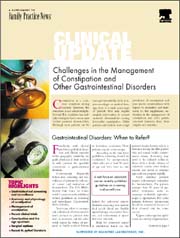
To view the supplement, click the image above.
Topic Highlights
Gastrointestinal Disorders: When to Refer?
Understanding the Anatomy and Physiology of Constipation
Lawrence R. Schiller, MD, FACP, FACG
Program Director, Gastroenterology Fellowship
Department of Gastroenterology
Baylor University Medical Center
Dallas, TX
Consultant: Braintree Laboratories, Inc. and Novartis Pharmaceuticals. He discusses the unlabeled use of tegaserod for constipation. He also discusses the investigational use of NT-3 for constipation.
Management of Constipation Begins With Attention to Clinical Details
Jack A. DiPalma, MD, FACP, FACG
Professor and Director
Division of Gastroenterology
University of South Alabama College of Medicine
Mobile, AL
Grant/Research Support and Consultant: Braintree Laboratories, Inc.
Recent Clinical Trials Provide Stronger Basis for Constipation Therapy
Lawrence R. Schiller, MD, FACP, FACG
Patients at Opposite Ends of the Age Spectrum Share Clinical Features of Constipation
Jack A. DiPalma, MD, FACP, FACG
Surgical Treatment for Chronic Constipation: Favorable Option in Selected Patients
David E. Beck, MD, FACS
Chairman, Department of Colon and Rectal Surgery
Ochsner Clinical Foundation
New Orleans, LA
Nothing to disclose.
Recent H. pylori Literature Explores New Questions
Copyright © 2003 by International Medical News Group
A supplement to Family Practice News.
This Clinical Update is supported by Braintree Laboratories, Inc.
The articles are based on interviews with the faculty.

To view the supplement, click the image above.
Topic Highlights
Gastrointestinal Disorders: When to Refer?
Understanding the Anatomy and Physiology of Constipation
Lawrence R. Schiller, MD, FACP, FACG
Program Director, Gastroenterology Fellowship
Department of Gastroenterology
Baylor University Medical Center
Dallas, TX
Consultant: Braintree Laboratories, Inc. and Novartis Pharmaceuticals. He discusses the unlabeled use of tegaserod for constipation. He also discusses the investigational use of NT-3 for constipation.
Management of Constipation Begins With Attention to Clinical Details
Jack A. DiPalma, MD, FACP, FACG
Professor and Director
Division of Gastroenterology
University of South Alabama College of Medicine
Mobile, AL
Grant/Research Support and Consultant: Braintree Laboratories, Inc.
Recent Clinical Trials Provide Stronger Basis for Constipation Therapy
Lawrence R. Schiller, MD, FACP, FACG
Patients at Opposite Ends of the Age Spectrum Share Clinical Features of Constipation
Jack A. DiPalma, MD, FACP, FACG
Surgical Treatment for Chronic Constipation: Favorable Option in Selected Patients
David E. Beck, MD, FACS
Chairman, Department of Colon and Rectal Surgery
Ochsner Clinical Foundation
New Orleans, LA
Nothing to disclose.
Recent H. pylori Literature Explores New Questions
Copyright © 2003 by International Medical News Group
A supplement to Family Practice News.
This Clinical Update is supported by Braintree Laboratories, Inc.
The articles are based on interviews with the faculty.

To view the supplement, click the image above.
Topic Highlights
Gastrointestinal Disorders: When to Refer?
Understanding the Anatomy and Physiology of Constipation
Lawrence R. Schiller, MD, FACP, FACG
Program Director, Gastroenterology Fellowship
Department of Gastroenterology
Baylor University Medical Center
Dallas, TX
Consultant: Braintree Laboratories, Inc. and Novartis Pharmaceuticals. He discusses the unlabeled use of tegaserod for constipation. He also discusses the investigational use of NT-3 for constipation.
Management of Constipation Begins With Attention to Clinical Details
Jack A. DiPalma, MD, FACP, FACG
Professor and Director
Division of Gastroenterology
University of South Alabama College of Medicine
Mobile, AL
Grant/Research Support and Consultant: Braintree Laboratories, Inc.
Recent Clinical Trials Provide Stronger Basis for Constipation Therapy
Lawrence R. Schiller, MD, FACP, FACG
Patients at Opposite Ends of the Age Spectrum Share Clinical Features of Constipation
Jack A. DiPalma, MD, FACP, FACG
Surgical Treatment for Chronic Constipation: Favorable Option in Selected Patients
David E. Beck, MD, FACS
Chairman, Department of Colon and Rectal Surgery
Ochsner Clinical Foundation
New Orleans, LA
Nothing to disclose.
Recent H. pylori Literature Explores New Questions
Copyright © 2003 by International Medical News Group
Managing Acid-Related Disorders Through the Ages of Mankind
A supplement to Family Practice News supported by a restricted grant from TAP Pharmaceutical Products, Inc.
Symposium Highlights of articles based on presentations given at a continuing medical education symposium held on October 22, 2002, in Seattle, Wash.
GERD OFTEN OVERLOOKED IN PEDIATRIC PATIENTS PROTON PUMP INHIBITORS REMAIN STANDARD FOR GERD HEALING AND PREVENTION OF NSAID-ASSOCIATED GASTRIC ULCERS IN ELDERLY PATIENTS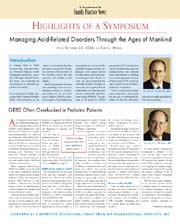
To view the supplement, click the image above.
INTRODUCTION
A.Mark Fendrick, MD
Associate Professor of Internal Medicine, Health Management & Policy
University of Michigan Medical Center
Ann Arbor, MI
Research Grants: TAP Pharmaceutical Products, Inc., Procter & Gamble Company, Merck & Co., Inc.; Consultant: TAP, AstraZeneca, Procter & Gamble, McNeil-PPC, Inc., Merck; Speaker: TAP.
Harland S. Winter, MD
Director, Pediatric Inflammatory Bowel Disease Center
Massachusetts General Hospital for Children
Harvard Medical School
Boston, MA
Grants: Procter & Gamble, AstraZeneca, TAP, Wyeth, Centocor, Inc., Elan, Con Agra; Research Support: Procter & Gamble, the Anneberg Center; Consultant: AstraZeneca, Wyeth.
Richard H. Hunt, FRCP, FRCP(C), FACG
Professor of Medicine
McMaster University Medical Centre
Hamilton, Ont.
Consultant: Abbott Laboratories, Axcan Pharma Inc., AstraZeneca, Merck & Co., Novartis Pharmaceuticals Corp., Procter & Gamble Co., TAP Pharmaceutical Products, Inc.; Investigator: Axcan, AstraZeneca, Merck, TAP.
David A. Peura, MD, FACG, FACP
Professor of Medicine
University of Virginia Health Sciences Center
Charlottesville, VA
Speaker: TAP, AstraZeneca, Wyeth, McNeil, Merck.
Copyright © 2002 by International Medical News Group
A supplement to Family Practice News supported by a restricted grant from TAP Pharmaceutical Products, Inc.
Symposium Highlights of articles based on presentations given at a continuing medical education symposium held on October 22, 2002, in Seattle, Wash.
GERD OFTEN OVERLOOKED IN PEDIATRIC PATIENTS PROTON PUMP INHIBITORS REMAIN STANDARD FOR GERD HEALING AND PREVENTION OF NSAID-ASSOCIATED GASTRIC ULCERS IN ELDERLY PATIENTS
To view the supplement, click the image above.
INTRODUCTION
A.Mark Fendrick, MD
Associate Professor of Internal Medicine, Health Management & Policy
University of Michigan Medical Center
Ann Arbor, MI
Research Grants: TAP Pharmaceutical Products, Inc., Procter & Gamble Company, Merck & Co., Inc.; Consultant: TAP, AstraZeneca, Procter & Gamble, McNeil-PPC, Inc., Merck; Speaker: TAP.
Harland S. Winter, MD
Director, Pediatric Inflammatory Bowel Disease Center
Massachusetts General Hospital for Children
Harvard Medical School
Boston, MA
Grants: Procter & Gamble, AstraZeneca, TAP, Wyeth, Centocor, Inc., Elan, Con Agra; Research Support: Procter & Gamble, the Anneberg Center; Consultant: AstraZeneca, Wyeth.
Richard H. Hunt, FRCP, FRCP(C), FACG
Professor of Medicine
McMaster University Medical Centre
Hamilton, Ont.
Consultant: Abbott Laboratories, Axcan Pharma Inc., AstraZeneca, Merck & Co., Novartis Pharmaceuticals Corp., Procter & Gamble Co., TAP Pharmaceutical Products, Inc.; Investigator: Axcan, AstraZeneca, Merck, TAP.
David A. Peura, MD, FACG, FACP
Professor of Medicine
University of Virginia Health Sciences Center
Charlottesville, VA
Speaker: TAP, AstraZeneca, Wyeth, McNeil, Merck.
Copyright © 2002 by International Medical News Group
A supplement to Family Practice News supported by a restricted grant from TAP Pharmaceutical Products, Inc.
Symposium Highlights of articles based on presentations given at a continuing medical education symposium held on October 22, 2002, in Seattle, Wash.
GERD OFTEN OVERLOOKED IN PEDIATRIC PATIENTS PROTON PUMP INHIBITORS REMAIN STANDARD FOR GERD HEALING AND PREVENTION OF NSAID-ASSOCIATED GASTRIC ULCERS IN ELDERLY PATIENTS
To view the supplement, click the image above.
INTRODUCTION
A.Mark Fendrick, MD
Associate Professor of Internal Medicine, Health Management & Policy
University of Michigan Medical Center
Ann Arbor, MI
Research Grants: TAP Pharmaceutical Products, Inc., Procter & Gamble Company, Merck & Co., Inc.; Consultant: TAP, AstraZeneca, Procter & Gamble, McNeil-PPC, Inc., Merck; Speaker: TAP.
Harland S. Winter, MD
Director, Pediatric Inflammatory Bowel Disease Center
Massachusetts General Hospital for Children
Harvard Medical School
Boston, MA
Grants: Procter & Gamble, AstraZeneca, TAP, Wyeth, Centocor, Inc., Elan, Con Agra; Research Support: Procter & Gamble, the Anneberg Center; Consultant: AstraZeneca, Wyeth.
Richard H. Hunt, FRCP, FRCP(C), FACG
Professor of Medicine
McMaster University Medical Centre
Hamilton, Ont.
Consultant: Abbott Laboratories, Axcan Pharma Inc., AstraZeneca, Merck & Co., Novartis Pharmaceuticals Corp., Procter & Gamble Co., TAP Pharmaceutical Products, Inc.; Investigator: Axcan, AstraZeneca, Merck, TAP.
David A. Peura, MD, FACG, FACP
Professor of Medicine
University of Virginia Health Sciences Center
Charlottesville, VA
Speaker: TAP, AstraZeneca, Wyeth, McNeil, Merck.
Copyright © 2002 by International Medical News Group
New Benchmarks in Acid-Related Disorders: A Debate With the Experts
A supplement to Family Practice News supported by a restricted grant from TAP Pharmaceutical Products, Inc.
Symposium Highlights of articles based on presentations given at a continuing medical education symposium held on May 19, 2002, in San Francisco, Calif.
USE OF NONSELECTIVE NSAIDS, CYCLOOXYGENASE INHIBITORS, AND PROTON PUMP INHIBITORS Treat With Cyclooxygenase Inhibitors OPTIONS IN THE LONG-TERM MAINTENANCE OF GASTROESOPHAGEAL REFLUX DISEASE Management on Long-Term PPI Therapy IS SCREENING FOR BARRETT'S ESOPHAGUS NECESSARY? Screenings Not Cost-Effective ENDOSCOPY-NEGATIVE REFLUX DISEASE: ACID-RELATED DISORDER OR FUNCTIONAL DISORDER? Endoscopy-Negative Reflux Disease Is a Functional Disorder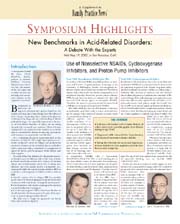
To view the supplement, click the image above.
INTRODUCTION
Richard H. Hunt, FRCP, FRCP(C), FACG
Professor of Medicine
McMaster University Medical Centre
Hamilton, Ont.
Consultant: Abbott Laboratories, Axcan Pharma Inc., AstraZeneca, Merck & Co., Novartis Pharmaceuticals Corp., Procter & Gamble Co., TAP Pharmaceutical Products, Inc.; Investigator: Axcan, AstraZeneca, Merck, TAP.
Treat With Nonselective NSAIDs, plus PPIs
Michael B. Kimmey, MD
Professor of Medicine and Director of Gastrointestinal Endoscopy
University of Washington
Seattle, WA
Nothing to disclose.
Jay L. Goldstein, MD
Professor of Medicine
Vice Head for Clinical Affairs
Department of Medicine
University of Illinois
Chicago, IL
Consultant & Grant Support: AstraZeneca, Pharmacia Corp., Pfizer Inc., TAP.
Endoscopic/Surgical Intervention
George Triadafilopoulos, MD
Professor of Medicine
Stanford University School of Medicine
Chief, Section of Gastroenterology
Palo Alto Veterans Affairs Health Care System
Palo Alto, CA
Consultant: Curon Medical Inc., TAP; Grant Support: AstraZeneca; Speakers' Bureau: AstraZeneca, Curon, Janssen, TAP, Wyeth; Equity: Curon.
Colin W. Howden, MD, FACG
Professor of Medicine
Northwestern University Feinberg School of Medicine
Chicago, IL
Consultant: Prometheus, Takeda Pharma, TAP; Investigator: TAP, Merck; Grant Support: AstraZeneca; Speakers' Bureau: AstraZeneca, Merck, TAP, Wyeth.
Good Evidence for Screening
Roy K.H. Wong, MD, FACG
Professor of Medicine
Director of the Division of Digestive Diseases
Uniformed Services University of the Health Sciences
Bethesda, MD
Grant Support: ACG, AstraZeneca, Janssen.
Dawn Provenzale, MD
Associate Professor & Director of GI Outcomes Research
Duke University Medical Center
Durham, N.C.
Nothing to disclose.
Endoscopy-Negative Reflux Disease Is an Acid-Related Disorder
Joel E. Richter, MD
Professor of Medicine and Chairman
Department of Gastroenterology and Hepatology
Cleveland Clinic Foundation
Cleveland, OH
Consultant: AstraZeneca, TAP; Speakers' Bureau: AstraZeneca, Janssen, TAP, Wyeth.
William D. Chey, MD, FACG, FACP
Associate Professor of Medicine
Director of GI Physiology Laboratory
University of Michigan
Ann Arbor, MI
Consultant: AstraZeneca, TAP; Grant Support: AstraZeneca; Speakers' Bureau: AstraZeneca, Janssen Pharmaceutica, Inc., TAP.
Copyright © 2002 by International Medical News Group
A supplement to Family Practice News supported by a restricted grant from TAP Pharmaceutical Products, Inc.
Symposium Highlights of articles based on presentations given at a continuing medical education symposium held on May 19, 2002, in San Francisco, Calif.
USE OF NONSELECTIVE NSAIDS, CYCLOOXYGENASE INHIBITORS, AND PROTON PUMP INHIBITORS Treat With Cyclooxygenase Inhibitors OPTIONS IN THE LONG-TERM MAINTENANCE OF GASTROESOPHAGEAL REFLUX DISEASE Management on Long-Term PPI Therapy IS SCREENING FOR BARRETT'S ESOPHAGUS NECESSARY? Screenings Not Cost-Effective ENDOSCOPY-NEGATIVE REFLUX DISEASE: ACID-RELATED DISORDER OR FUNCTIONAL DISORDER? Endoscopy-Negative Reflux Disease Is a Functional Disorder
To view the supplement, click the image above.
INTRODUCTION
Richard H. Hunt, FRCP, FRCP(C), FACG
Professor of Medicine
McMaster University Medical Centre
Hamilton, Ont.
Consultant: Abbott Laboratories, Axcan Pharma Inc., AstraZeneca, Merck & Co., Novartis Pharmaceuticals Corp., Procter & Gamble Co., TAP Pharmaceutical Products, Inc.; Investigator: Axcan, AstraZeneca, Merck, TAP.
Treat With Nonselective NSAIDs, plus PPIs
Michael B. Kimmey, MD
Professor of Medicine and Director of Gastrointestinal Endoscopy
University of Washington
Seattle, WA
Nothing to disclose.
Jay L. Goldstein, MD
Professor of Medicine
Vice Head for Clinical Affairs
Department of Medicine
University of Illinois
Chicago, IL
Consultant & Grant Support: AstraZeneca, Pharmacia Corp., Pfizer Inc., TAP.
Endoscopic/Surgical Intervention
George Triadafilopoulos, MD
Professor of Medicine
Stanford University School of Medicine
Chief, Section of Gastroenterology
Palo Alto Veterans Affairs Health Care System
Palo Alto, CA
Consultant: Curon Medical Inc., TAP; Grant Support: AstraZeneca; Speakers' Bureau: AstraZeneca, Curon, Janssen, TAP, Wyeth; Equity: Curon.
Colin W. Howden, MD, FACG
Professor of Medicine
Northwestern University Feinberg School of Medicine
Chicago, IL
Consultant: Prometheus, Takeda Pharma, TAP; Investigator: TAP, Merck; Grant Support: AstraZeneca; Speakers' Bureau: AstraZeneca, Merck, TAP, Wyeth.
Good Evidence for Screening
Roy K.H. Wong, MD, FACG
Professor of Medicine
Director of the Division of Digestive Diseases
Uniformed Services University of the Health Sciences
Bethesda, MD
Grant Support: ACG, AstraZeneca, Janssen.
Dawn Provenzale, MD
Associate Professor & Director of GI Outcomes Research
Duke University Medical Center
Durham, N.C.
Nothing to disclose.
Endoscopy-Negative Reflux Disease Is an Acid-Related Disorder
Joel E. Richter, MD
Professor of Medicine and Chairman
Department of Gastroenterology and Hepatology
Cleveland Clinic Foundation
Cleveland, OH
Consultant: AstraZeneca, TAP; Speakers' Bureau: AstraZeneca, Janssen, TAP, Wyeth.
William D. Chey, MD, FACG, FACP
Associate Professor of Medicine
Director of GI Physiology Laboratory
University of Michigan
Ann Arbor, MI
Consultant: AstraZeneca, TAP; Grant Support: AstraZeneca; Speakers' Bureau: AstraZeneca, Janssen Pharmaceutica, Inc., TAP.
Copyright © 2002 by International Medical News Group
A supplement to Family Practice News supported by a restricted grant from TAP Pharmaceutical Products, Inc.
Symposium Highlights of articles based on presentations given at a continuing medical education symposium held on May 19, 2002, in San Francisco, Calif.
USE OF NONSELECTIVE NSAIDS, CYCLOOXYGENASE INHIBITORS, AND PROTON PUMP INHIBITORS Treat With Cyclooxygenase Inhibitors OPTIONS IN THE LONG-TERM MAINTENANCE OF GASTROESOPHAGEAL REFLUX DISEASE Management on Long-Term PPI Therapy IS SCREENING FOR BARRETT'S ESOPHAGUS NECESSARY? Screenings Not Cost-Effective ENDOSCOPY-NEGATIVE REFLUX DISEASE: ACID-RELATED DISORDER OR FUNCTIONAL DISORDER? Endoscopy-Negative Reflux Disease Is a Functional Disorder
To view the supplement, click the image above.
INTRODUCTION
Richard H. Hunt, FRCP, FRCP(C), FACG
Professor of Medicine
McMaster University Medical Centre
Hamilton, Ont.
Consultant: Abbott Laboratories, Axcan Pharma Inc., AstraZeneca, Merck & Co., Novartis Pharmaceuticals Corp., Procter & Gamble Co., TAP Pharmaceutical Products, Inc.; Investigator: Axcan, AstraZeneca, Merck, TAP.
Treat With Nonselective NSAIDs, plus PPIs
Michael B. Kimmey, MD
Professor of Medicine and Director of Gastrointestinal Endoscopy
University of Washington
Seattle, WA
Nothing to disclose.
Jay L. Goldstein, MD
Professor of Medicine
Vice Head for Clinical Affairs
Department of Medicine
University of Illinois
Chicago, IL
Consultant & Grant Support: AstraZeneca, Pharmacia Corp., Pfizer Inc., TAP.
Endoscopic/Surgical Intervention
George Triadafilopoulos, MD
Professor of Medicine
Stanford University School of Medicine
Chief, Section of Gastroenterology
Palo Alto Veterans Affairs Health Care System
Palo Alto, CA
Consultant: Curon Medical Inc., TAP; Grant Support: AstraZeneca; Speakers' Bureau: AstraZeneca, Curon, Janssen, TAP, Wyeth; Equity: Curon.
Colin W. Howden, MD, FACG
Professor of Medicine
Northwestern University Feinberg School of Medicine
Chicago, IL
Consultant: Prometheus, Takeda Pharma, TAP; Investigator: TAP, Merck; Grant Support: AstraZeneca; Speakers' Bureau: AstraZeneca, Merck, TAP, Wyeth.
Good Evidence for Screening
Roy K.H. Wong, MD, FACG
Professor of Medicine
Director of the Division of Digestive Diseases
Uniformed Services University of the Health Sciences
Bethesda, MD
Grant Support: ACG, AstraZeneca, Janssen.
Dawn Provenzale, MD
Associate Professor & Director of GI Outcomes Research
Duke University Medical Center
Durham, N.C.
Nothing to disclose.
Endoscopy-Negative Reflux Disease Is an Acid-Related Disorder
Joel E. Richter, MD
Professor of Medicine and Chairman
Department of Gastroenterology and Hepatology
Cleveland Clinic Foundation
Cleveland, OH
Consultant: AstraZeneca, TAP; Speakers' Bureau: AstraZeneca, Janssen, TAP, Wyeth.
William D. Chey, MD, FACG, FACP
Associate Professor of Medicine
Director of GI Physiology Laboratory
University of Michigan
Ann Arbor, MI
Consultant: AstraZeneca, TAP; Grant Support: AstraZeneca; Speakers' Bureau: AstraZeneca, Janssen Pharmaceutica, Inc., TAP.
Copyright © 2002 by International Medical News Group
Observations on the CATIE Schizophrenia StudyHow Should the Data Be Translated Into Clinical Practice?
How Should the Data Be Translated Into Clinical Practice?
A supplement to Clinical Psychiatry News and supported by Pfizer, Inc.
A panel of experts met in November 2005 in Washington, DC, to discuss the first published results of the Clinical Antipsychotic Trials of Intervention Effectiveness (CATIE) schizophrenia study. Participants included several principal study investigators as well as experts in the treatment and management of schizophrenia and bipolar illness. The content of this supplement is based in part on that discussion.
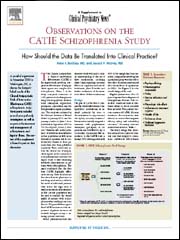
Click Here to view the supplement.
Faculty
Peter F. Buckley, MD
Medical College of Georgia
School of Medicine
Grant/Research Support: Astra/Zeneca, Bristol-Myers Squibb Company, Eli Lilly and Company, Janssen Pharmaceutica, LP, Pfizer Inc., and Solvay Pharmaceuticals, Inc. Consultant/Received Honoraria: Abbott Laboratories, Alamo Pharmaceuticals, LLC, AstraZeneca, Bristol-Myers Squibb, Eli Lilly, Janssen, and Pfizer.
Joseph P. McEvoy, MD
Duke University
Medical Center
Clinical Grant Support: AstraZeneca, Bristol-Myers Squibb, Eli Lilly, Janssen, and Pfizer Inc. Consultant: GlaxoSmithKline, Eli Lilly, and Pfizer.
Topics
• Design
• Overview of Results
• Dosing
• Metabolics
• Clinical Implications of CATIE Phase I
• Beyond Phase I
• Implications of CATIE Beyond Schizophrenia
• Conclusion
A supplement to Clinical Psychiatry News and supported by Pfizer, Inc.
A panel of experts met in November 2005 in Washington, DC, to discuss the first published results of the Clinical Antipsychotic Trials of Intervention Effectiveness (CATIE) schizophrenia study. Participants included several principal study investigators as well as experts in the treatment and management of schizophrenia and bipolar illness. The content of this supplement is based in part on that discussion.

Click Here to view the supplement.
Faculty
Peter F. Buckley, MD
Medical College of Georgia
School of Medicine
Grant/Research Support: Astra/Zeneca, Bristol-Myers Squibb Company, Eli Lilly and Company, Janssen Pharmaceutica, LP, Pfizer Inc., and Solvay Pharmaceuticals, Inc. Consultant/Received Honoraria: Abbott Laboratories, Alamo Pharmaceuticals, LLC, AstraZeneca, Bristol-Myers Squibb, Eli Lilly, Janssen, and Pfizer.
Joseph P. McEvoy, MD
Duke University
Medical Center
Clinical Grant Support: AstraZeneca, Bristol-Myers Squibb, Eli Lilly, Janssen, and Pfizer Inc. Consultant: GlaxoSmithKline, Eli Lilly, and Pfizer.
Topics
• Design
• Overview of Results
• Dosing
• Metabolics
• Clinical Implications of CATIE Phase I
• Beyond Phase I
• Implications of CATIE Beyond Schizophrenia
• Conclusion
A supplement to Clinical Psychiatry News and supported by Pfizer, Inc.
A panel of experts met in November 2005 in Washington, DC, to discuss the first published results of the Clinical Antipsychotic Trials of Intervention Effectiveness (CATIE) schizophrenia study. Participants included several principal study investigators as well as experts in the treatment and management of schizophrenia and bipolar illness. The content of this supplement is based in part on that discussion.

Click Here to view the supplement.
Faculty
Peter F. Buckley, MD
Medical College of Georgia
School of Medicine
Grant/Research Support: Astra/Zeneca, Bristol-Myers Squibb Company, Eli Lilly and Company, Janssen Pharmaceutica, LP, Pfizer Inc., and Solvay Pharmaceuticals, Inc. Consultant/Received Honoraria: Abbott Laboratories, Alamo Pharmaceuticals, LLC, AstraZeneca, Bristol-Myers Squibb, Eli Lilly, Janssen, and Pfizer.
Joseph P. McEvoy, MD
Duke University
Medical Center
Clinical Grant Support: AstraZeneca, Bristol-Myers Squibb, Eli Lilly, Janssen, and Pfizer Inc. Consultant: GlaxoSmithKline, Eli Lilly, and Pfizer.
Topics
• Design
• Overview of Results
• Dosing
• Metabolics
• Clinical Implications of CATIE Phase I
• Beyond Phase I
• Implications of CATIE Beyond Schizophrenia
• Conclusion
How Should the Data Be Translated Into Clinical Practice?
How Should the Data Be Translated Into Clinical Practice?
Practical Treatment Strategies for the Successful Management of Bipolar Disorder
A supplement to Clinical Psychiatry News and supported by Lilly.
This supplement has been developed based on the "New Clinical Strategies for the Recognition and Treatment of Bipolar Disorder: Can We Successfully Advance Care?" program that took place on September 14-15, 2007, in San Antonio, Texas. The intent is to provide best practices to clinicians relative to the diagnosis and treatment of bipolar disorder across the life span.
•FACULTY
•TARGET AUDIENCE
•EDUCATIONAL NEEDS
•LEARNING OBJECTIVES
•ACCREDITATION STATEMENT
•CREDIT DESIGNATION
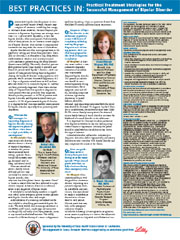
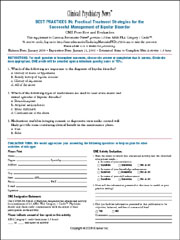
To view the supplement, click the image above. To take the CME Posttest, download and print out the CME Posttest PDF file, and follow the test instructions.
FACULTY
Robert M.A. Hirschfeld, MDCo-Chair
Titus H. Harris Chair,
Harry K. Davis Professor,
Professor and Chair
Department of Psychiatry and Behavioral Sciences
The University of Texas Medical Branch
Galveston, Tex.
Dr Hirschfeld is a consultant and/or has participated in advisory boards for Abbott Laboratories, AstraZeneca, Bristol-Myers Squibb, Cephalon, Eli Lilly, Forest Laboratories, GlaxoSmithKline, Janssen Pharmaceutica, Jazz Pharmaceuticals, KV Pharmaceutical, Novartis, Organon, Ortho-McNeil, Pfizer, Shire, Solvay Pharmaceuticals, and Wyeth-Ayerst.
Karen Dineen Wagner, MD, PhD
Marie B. Gale
Centennial Professor and Vice Chair
Department of Psychiatry and Behavioral Sciences
Director, Division of Child and Adolescent Psychiatry
The University of Texas Medical Branch
Galveston, Tex.
Dr Wagner receives grant/research support from the National Institute of Mental Health (NIMH) and is a consultant and/or has participated in advisory boards for Abbott Laboratories, AstraZeneca, Bristol-Myers Squibb, Eli Lilly, Forest Laboratories, Janssen Pharmaceutica, Novartis, and Otsuka.
S. Nassir Ghaemi, MD, MPH
Associate Professor of Psychiatry and Public Health
Director, Bipolar Disorder Research Program
Emory University
Atlanta, Ga.
Dr Ghaemi receives research grants from, has participated in advisory boards for, and/or is on the speaker
A supplement to Clinical Psychiatry News and supported by Lilly.
This supplement has been developed based on the "New Clinical Strategies for the Recognition and Treatment of Bipolar Disorder: Can We Successfully Advance Care?" program that took place on September 14-15, 2007, in San Antonio, Texas. The intent is to provide best practices to clinicians relative to the diagnosis and treatment of bipolar disorder across the life span.
•FACULTY
•TARGET AUDIENCE
•EDUCATIONAL NEEDS
•LEARNING OBJECTIVES
•ACCREDITATION STATEMENT
•CREDIT DESIGNATION


To view the supplement, click the image above. To take the CME Posttest, download and print out the CME Posttest PDF file, and follow the test instructions.
FACULTY
Robert M.A. Hirschfeld, MDCo-Chair
Titus H. Harris Chair,
Harry K. Davis Professor,
Professor and Chair
Department of Psychiatry and Behavioral Sciences
The University of Texas Medical Branch
Galveston, Tex.
Dr Hirschfeld is a consultant and/or has participated in advisory boards for Abbott Laboratories, AstraZeneca, Bristol-Myers Squibb, Cephalon, Eli Lilly, Forest Laboratories, GlaxoSmithKline, Janssen Pharmaceutica, Jazz Pharmaceuticals, KV Pharmaceutical, Novartis, Organon, Ortho-McNeil, Pfizer, Shire, Solvay Pharmaceuticals, and Wyeth-Ayerst.
Karen Dineen Wagner, MD, PhD
Marie B. Gale
Centennial Professor and Vice Chair
Department of Psychiatry and Behavioral Sciences
Director, Division of Child and Adolescent Psychiatry
The University of Texas Medical Branch
Galveston, Tex.
Dr Wagner receives grant/research support from the National Institute of Mental Health (NIMH) and is a consultant and/or has participated in advisory boards for Abbott Laboratories, AstraZeneca, Bristol-Myers Squibb, Eli Lilly, Forest Laboratories, Janssen Pharmaceutica, Novartis, and Otsuka.
S. Nassir Ghaemi, MD, MPH
Associate Professor of Psychiatry and Public Health
Director, Bipolar Disorder Research Program
Emory University
Atlanta, Ga.
Dr Ghaemi receives research grants from, has participated in advisory boards for, and/or is on the speaker
A supplement to Clinical Psychiatry News and supported by Lilly.
This supplement has been developed based on the "New Clinical Strategies for the Recognition and Treatment of Bipolar Disorder: Can We Successfully Advance Care?" program that took place on September 14-15, 2007, in San Antonio, Texas. The intent is to provide best practices to clinicians relative to the diagnosis and treatment of bipolar disorder across the life span.
•FACULTY
•TARGET AUDIENCE
•EDUCATIONAL NEEDS
•LEARNING OBJECTIVES
•ACCREDITATION STATEMENT
•CREDIT DESIGNATION


To view the supplement, click the image above. To take the CME Posttest, download and print out the CME Posttest PDF file, and follow the test instructions.
FACULTY
Robert M.A. Hirschfeld, MDCo-Chair
Titus H. Harris Chair,
Harry K. Davis Professor,
Professor and Chair
Department of Psychiatry and Behavioral Sciences
The University of Texas Medical Branch
Galveston, Tex.
Dr Hirschfeld is a consultant and/or has participated in advisory boards for Abbott Laboratories, AstraZeneca, Bristol-Myers Squibb, Cephalon, Eli Lilly, Forest Laboratories, GlaxoSmithKline, Janssen Pharmaceutica, Jazz Pharmaceuticals, KV Pharmaceutical, Novartis, Organon, Ortho-McNeil, Pfizer, Shire, Solvay Pharmaceuticals, and Wyeth-Ayerst.
Karen Dineen Wagner, MD, PhD
Marie B. Gale
Centennial Professor and Vice Chair
Department of Psychiatry and Behavioral Sciences
Director, Division of Child and Adolescent Psychiatry
The University of Texas Medical Branch
Galveston, Tex.
Dr Wagner receives grant/research support from the National Institute of Mental Health (NIMH) and is a consultant and/or has participated in advisory boards for Abbott Laboratories, AstraZeneca, Bristol-Myers Squibb, Eli Lilly, Forest Laboratories, Janssen Pharmaceutica, Novartis, and Otsuka.
S. Nassir Ghaemi, MD, MPH
Associate Professor of Psychiatry and Public Health
Director, Bipolar Disorder Research Program
Emory University
Atlanta, Ga.
Dr Ghaemi receives research grants from, has participated in advisory boards for, and/or is on the speaker
Abuse Potential of Sleeping Agents: Liability Varies Among Agents
A supplement to Clinical Psychiatry News.
This CLINICAL UPDATE is supported by Takeda Pharmaceuticals North America, Inc.
•Introduction
•Topic Highlights
Click Here to view the supplement.
Introduction
Introduction
Roland R. Griffiths, PhD
Professor of Behavioral Biology
Departments of Psychiatry and Neuroscience
Johns Hopkins University
School of Medicine
Baltimore, Md.
Dr. Griffiths has disclosed that he is Principal Investigator of two grants from the National Institute on Drug Abuse (NIDA) (R01 DA03889 and R01 DA03890) and co-investigator on a contract and several other grants from NIDA. During the past 5 years, on issues about drug abuse liability, he has been a consultant to or received grants from the following pharmaceutical companies: Abbott Laboratories, Forest Laboratories Inc., Merck & Co., Inc., Neurocrine Biosciences, Inc., Novartis Pharmaceuticals Corporation, Orphan Medical, Pharmacia Corporation, Pfizer Inc., Takeda Pharmaceuticals, TransOral Pharmaceucticals, Inc., Somaxon Pharmaceuticals Inc., and Wyeth Pharmaceuticals. He has disclosed that he will be discussing non-medical use (ie, abuse) of various hypnotic drugs.
Topic Highlights
• Abuse Potential of Sleeping Agents: Liability Varies Among Agents
Insomnia: A Brief Review
Effects of Insomnia
Pharmacologic Treatment of Insomnia
Patterns of Sedative/Hypnotic Abuse
• Abuse Potential of Hypnotic Agents: Study Evaluates Relative Abuse Liability
Defining Relative Abuse Liability and Toxicity
Relative Abuse Liability Table
Results of Analysis
Copyright © 2006 Elsevier Inc.
A supplement to Clinical Psychiatry News.
This CLINICAL UPDATE is supported by Takeda Pharmaceuticals North America, Inc.
•Introduction
•Topic Highlights
Click Here to view the supplement.
Introduction
Introduction
Roland R. Griffiths, PhD
Professor of Behavioral Biology
Departments of Psychiatry and Neuroscience
Johns Hopkins University
School of Medicine
Baltimore, Md.
Dr. Griffiths has disclosed that he is Principal Investigator of two grants from the National Institute on Drug Abuse (NIDA) (R01 DA03889 and R01 DA03890) and co-investigator on a contract and several other grants from NIDA. During the past 5 years, on issues about drug abuse liability, he has been a consultant to or received grants from the following pharmaceutical companies: Abbott Laboratories, Forest Laboratories Inc., Merck & Co., Inc., Neurocrine Biosciences, Inc., Novartis Pharmaceuticals Corporation, Orphan Medical, Pharmacia Corporation, Pfizer Inc., Takeda Pharmaceuticals, TransOral Pharmaceucticals, Inc., Somaxon Pharmaceuticals Inc., and Wyeth Pharmaceuticals. He has disclosed that he will be discussing non-medical use (ie, abuse) of various hypnotic drugs.
Topic Highlights
• Abuse Potential of Sleeping Agents: Liability Varies Among Agents
Insomnia: A Brief Review
Effects of Insomnia
Pharmacologic Treatment of Insomnia
Patterns of Sedative/Hypnotic Abuse
• Abuse Potential of Hypnotic Agents: Study Evaluates Relative Abuse Liability
Defining Relative Abuse Liability and Toxicity
Relative Abuse Liability Table
Results of Analysis
Copyright © 2006 Elsevier Inc.
A supplement to Clinical Psychiatry News.
This CLINICAL UPDATE is supported by Takeda Pharmaceuticals North America, Inc.
•Introduction
•Topic Highlights
Click Here to view the supplement.
Introduction
Introduction
Roland R. Griffiths, PhD
Professor of Behavioral Biology
Departments of Psychiatry and Neuroscience
Johns Hopkins University
School of Medicine
Baltimore, Md.
Dr. Griffiths has disclosed that he is Principal Investigator of two grants from the National Institute on Drug Abuse (NIDA) (R01 DA03889 and R01 DA03890) and co-investigator on a contract and several other grants from NIDA. During the past 5 years, on issues about drug abuse liability, he has been a consultant to or received grants from the following pharmaceutical companies: Abbott Laboratories, Forest Laboratories Inc., Merck & Co., Inc., Neurocrine Biosciences, Inc., Novartis Pharmaceuticals Corporation, Orphan Medical, Pharmacia Corporation, Pfizer Inc., Takeda Pharmaceuticals, TransOral Pharmaceucticals, Inc., Somaxon Pharmaceuticals Inc., and Wyeth Pharmaceuticals. He has disclosed that he will be discussing non-medical use (ie, abuse) of various hypnotic drugs.
Topic Highlights
• Abuse Potential of Sleeping Agents: Liability Varies Among Agents
Insomnia: A Brief Review
Effects of Insomnia
Pharmacologic Treatment of Insomnia
Patterns of Sedative/Hypnotic Abuse
• Abuse Potential of Hypnotic Agents: Study Evaluates Relative Abuse Liability
Defining Relative Abuse Liability and Toxicity
Relative Abuse Liability Table
Results of Analysis
Copyright © 2006 Elsevier Inc.
CLINICAL UPDATE: Selected Issues in Psychiatry
This CLINICAL UPDATE is supported by an educational grant from UCB Pharma, Inc., and is a supplement to Clinical Psychiatry News.
This supplement is based on a faculty interview and poster reviews.
Click Here To view the supplement.
Faculty
Joseph F. Goldberg, MD
Director of Bipolar Disorders Research
The Zucker Hillside Hospital-North Shore Long Island Jewish Health System
Glen Oaks, N.Y.
Received Funding for Clinical Grants/Consultant: Abbott Laboratories, AstraZeneca, Bristol-Myers Squibb Company, Eli Lilly and Company, and GlaxoSmithKline. He discusses the off-label use of levetiracetam for the treatment of psychiatric disorders.
Topics
• Anticonvulsants and Psychiatric Disorders
• Treatment of Varied Psychiatric Disorders in an Outpatient Setting
• Prevalence of ADHD in Adults
• Treatment of Mild or Moderate Bipolar Disorder
• Prevalence of Medical Comorbidity in Severe Psychiatric Disorders
• Evaluation of Therapy for Aggression Disorders
• Prevalence of Comorbid Anxiety Disorders
• Evaluation of Therapy for Bipolar Mania
• Evaluation of Add-On Therapy for Bipolar Disorder Therapy
Copyright © 2004 by International Medical News Group
This CLINICAL UPDATE is supported by an educational grant from UCB Pharma, Inc., and is a supplement to Clinical Psychiatry News.
This supplement is based on a faculty interview and poster reviews.
Click Here To view the supplement.
Faculty
Joseph F. Goldberg, MD
Director of Bipolar Disorders Research
The Zucker Hillside Hospital-North Shore Long Island Jewish Health System
Glen Oaks, N.Y.
Received Funding for Clinical Grants/Consultant: Abbott Laboratories, AstraZeneca, Bristol-Myers Squibb Company, Eli Lilly and Company, and GlaxoSmithKline. He discusses the off-label use of levetiracetam for the treatment of psychiatric disorders.
Topics
• Anticonvulsants and Psychiatric Disorders
• Treatment of Varied Psychiatric Disorders in an Outpatient Setting
• Prevalence of ADHD in Adults
• Treatment of Mild or Moderate Bipolar Disorder
• Prevalence of Medical Comorbidity in Severe Psychiatric Disorders
• Evaluation of Therapy for Aggression Disorders
• Prevalence of Comorbid Anxiety Disorders
• Evaluation of Therapy for Bipolar Mania
• Evaluation of Add-On Therapy for Bipolar Disorder Therapy
Copyright © 2004 by International Medical News Group
This CLINICAL UPDATE is supported by an educational grant from UCB Pharma, Inc., and is a supplement to Clinical Psychiatry News.
This supplement is based on a faculty interview and poster reviews.
Click Here To view the supplement.
Faculty
Joseph F. Goldberg, MD
Director of Bipolar Disorders Research
The Zucker Hillside Hospital-North Shore Long Island Jewish Health System
Glen Oaks, N.Y.
Received Funding for Clinical Grants/Consultant: Abbott Laboratories, AstraZeneca, Bristol-Myers Squibb Company, Eli Lilly and Company, and GlaxoSmithKline. He discusses the off-label use of levetiracetam for the treatment of psychiatric disorders.
Topics
• Anticonvulsants and Psychiatric Disorders
• Treatment of Varied Psychiatric Disorders in an Outpatient Setting
• Prevalence of ADHD in Adults
• Treatment of Mild or Moderate Bipolar Disorder
• Prevalence of Medical Comorbidity in Severe Psychiatric Disorders
• Evaluation of Therapy for Aggression Disorders
• Prevalence of Comorbid Anxiety Disorders
• Evaluation of Therapy for Bipolar Mania
• Evaluation of Add-On Therapy for Bipolar Disorder Therapy
Copyright © 2004 by International Medical News Group
BEST PRACTICES IN: Psychosocial Impact of Rosacea
A supplement to Skin & Allergy News. This supplement was sponsored by Galderma Laboratories, L.P.
- NRS Digital Perception Survey
- Presentation And Diagnosis
- Treatment Strategies
Faculty/Faculty Disclosure
Debra B. Luftman, MD
Coauthor of The Beauty Prescription:
The Complete Formula for Looking and Feeling Beautiful Calabasas, California
Dr Luftman has received funding for clinical grants from and is a consultant for Galderma Laboratories, L.P.
Copyright (c) 2011 Elsevier Inc.
A supplement to Skin & Allergy News. This supplement was sponsored by Galderma Laboratories, L.P.
- NRS Digital Perception Survey
- Presentation And Diagnosis
- Treatment Strategies
Faculty/Faculty Disclosure
Debra B. Luftman, MD
Coauthor of The Beauty Prescription:
The Complete Formula for Looking and Feeling Beautiful Calabasas, California
Dr Luftman has received funding for clinical grants from and is a consultant for Galderma Laboratories, L.P.
Copyright (c) 2011 Elsevier Inc.
A supplement to Skin & Allergy News. This supplement was sponsored by Galderma Laboratories, L.P.
- NRS Digital Perception Survey
- Presentation And Diagnosis
- Treatment Strategies
Faculty/Faculty Disclosure
Debra B. Luftman, MD
Coauthor of The Beauty Prescription:
The Complete Formula for Looking and Feeling Beautiful Calabasas, California
Dr Luftman has received funding for clinical grants from and is a consultant for Galderma Laboratories, L.P.
Copyright (c) 2011 Elsevier Inc.
10 practice, evidence-based suggestions to improve your gyn practice now
As a new year, and a new decade, open, attention to evidence-based guidelines and to outcomes for individual patients continues to drive medicine. As a busy practicing ObGyn, you’re challenged to sort through the great, and growing, mass of medical information so you can focus on key issues that improve care.
Faced with such a task, it’s not surprising that physicians are notoriously slow to make changes to their practice in response to new evidence.
Here is help. In this article, I present 10 succinct clinical topics and offer medical and surgical suggestions that are easy to put into practice and backed by evidence. If you haven’t already done so, implementing some of these ideas can immediately improve the quality of your care. For each suggestion, I’ve included the pertinent reference.
1. Banish error
Embrace, and immediately implement, surgical time-out and safety checklists for all your surgeries and office procedures.
Altpeter T, Luckhardt K, Lewis JN, Harken AH, Polk HC Jr. Expanded surgical time out: a key to real-time data collection and quality improvement. J Am Coll Surg. 2007;204(4):527–532.
Surgical errors are rare, but we need to continually aim for “zero-error” conditions. These two quality assurance tools may help our efforts.
2. Route of hysterectomy
Make an effort to perform more vaginal hysterectomies and fewer open abdominal hysterectomies.
ACOG Committee Opinion No. 444: Choosing the route of hysterectomy for benign disease. Obstet Gynecol. 2009;114(5):1156–1158.
In cases when vaginal hysterectomy isn’t feasible, consider laparoscopic (or, perhaps, robotic) hysterectomy more often. The role of robotic and single-port hysterectomies continues to evolve.
3. Cystoscopy
Learn, get credentialed for, and perform more diagnostic cystoscopies after certain gynecologic procedures.
ACOG Committee Opinion No. 372, July 2007. The role of cystourethroscopy in the generalist obstetrician-gynecologist practice. Obstet Gynecol. 2007;110(1):221–224.
Cystoscopy is appropriate when a gyn procedure carries at least a 1% risk of lower urinary tract injury. At most centers, that probably includes laparoscopic and robotic hysterectomy and colpopexy.
Simple cystoscopy at hysterectomy,
by Brent E. Seibel, MD
4. Oophorectomy
Perform fewer prophylactic oophorectomies at hysterectomy in low-risk women whose ovaries are normal. When you do remove ovaries as a preventive measure, do so with careful thought and informed consent—especially when the patient is premenopausal.
Parker WH, Broder MS, Chang E, et al. Ovarian conservation at the time of hysterectomy and long-term health outcomes in the Nurses’ Health Study. Obstet Gynecol. 2009;113(5):1027–1037.
In general, we probably perform too many “throw-in” oophorectomies at hysterectomy, with the aim of preventing cancer. But women who keep their ovaries may, in fact, live longer.
Give appropriate and properly timed (within 60 minutes of skin incision) antibiotic prophylaxis for hysterectomy, urogynecology procedures, hysterosalpingography or chromotubation, and surgical abortion.
ACOG Practice Bulletin No. 104: Antibiotic prophylaxis for gynecologic procedures. Obstet Gynecol. 2009;113(5):1180–1189.
A single-dose antibiotic is adequate before hysterectomy. Give a second dose when surgery will take more than 3 hours or, perhaps, blood loss is expected to be >1,500 mL. Subsequent doses are not indicated for prophylaxis alone. Antibiotic prophylaxis is unnecessary before diagnostic laparoscopy (level-A evidence), hysteroscopic surgery (level-B), or exploratory laparotomy (level-C).
6. Blind biopsy
For evaluation of abnormal uterine bleeding, perform fewer blind endometrial biopsies and more imaging studies, such as transvaginal ultrasonography or saline infusion sonography, or office hysteroscopy.
Goldstein SR. Modern evaluation of the endometrium. Obstet Gynecol. 2010;116(1):168–176.
Blind endometrial biopsy alone yields an unacceptably high rate of false-negative results when utilized to determine the cause of abnormal uterine bleeding.
Pretreat with misoprostol before hysteroscopic procedures.
Choksuchat C. Clinical use of misoprostol in non-pregnant women: review article. J Minim Invasive Gynecol. 2010;17(4):449–455.
Misoprostol eases the force of cervical dilation, results in fewer cervical lacerations and less fluid absorption, and may lead to fewer uterine perforations. The dosage: 200–400 μg orally or intravaginally, at bedtime, for 1 or 2 days before the procedure.
8. Vaginal estrogen
Use intravaginal estrogen therapy as first-line treatment for postmenopausal women who experience vaginal irritation, dyspareunia, and frequent cystitis.
Krause M, Wheeler TL, Richter HE, Snyder TE. Systemic effects of vaginally administered estrogen therapy: a review. Female Pelvic Med Reconstr Surg. 2010;16(3):188–195.
Vaginal estrogen has many clear quality-of-life benefits and carries relatively low risk; risk is probably much lower than what is reported with systemic hormone replacement therapy. Delivery can be by cream, suppository, or vaginal ring. The relatively high cost of vaginal estrogen therapy remains a problem for some women.
9. Vaginal apical support
Consider adding or augmenting some vaginal apical support to help your cystocele repairs.
Summers A, Winkel LA, Hussain HK, DeLancey JOL. The relationship between anterior and apical compartment support. Am J Obstet Gynecol. 2006;194(5):1438– 1443.
In women who have anterior vaginal prolapse (cystocele), approximately half of the prolapse might be explained by a defect in apical attachment. In addition, consider performing prophylactic McCall’s culdoplasty or uterosacral cuff suspension at the time of all hysterectomies, by all routes—even in the absence of prolapse.
Perform fewer, but better-timed, Pap tests.
Sawaya GF. Cervical-cancer screening—new guidelines and the balance between benefits and harms. N Engl J Med. 2009;361(26):2503–2305.
ACOG Practice Bulletin No. 109, December 2009. Cervical cytology screening. Obstet Gynecol. 2009;114(6):1409–1420.
New guidelines for cervical cancer screening that were issued by ACOG in November 2009 are meant to maximize benefit and minimize harm. The guidelines are summarized in the TABLE.
ACOG’s 2009 guidelines for cervical cytology screening
| Age (y) | Recommendation |
|---|---|
| Under 21 | Avoid screening |
| 21–29 | Screen every 2 y |
| 30–65 (or –70) | May screen every 3 y* |
| 65–70 | May discontinue screening† |
| *Applies only to women who have had three consecutive negative cytology tests; exceptions include women who have human immunodeficiency virus infection, compromised immunity, a history of grade-2 or -3 cervical intraepithelial neoplasia, or were exposed in utero to diethylstilbestrol. | |
| †Applies only to women who have had three or more consecutive negative cytology tests and no abnormal tests in the preceding 10 years; exceptions include women who have multiple sexual partners. | |
| Discontinue routine cytology in women who have had a total hysterectomy for benign indications and who do not have a history of high-grade cervical intraepithelial neoplasia (CIN). | |
We want to hear from you! Tell us what you think.
As a new year, and a new decade, open, attention to evidence-based guidelines and to outcomes for individual patients continues to drive medicine. As a busy practicing ObGyn, you’re challenged to sort through the great, and growing, mass of medical information so you can focus on key issues that improve care.
Faced with such a task, it’s not surprising that physicians are notoriously slow to make changes to their practice in response to new evidence.
Here is help. In this article, I present 10 succinct clinical topics and offer medical and surgical suggestions that are easy to put into practice and backed by evidence. If you haven’t already done so, implementing some of these ideas can immediately improve the quality of your care. For each suggestion, I’ve included the pertinent reference.
1. Banish error
Embrace, and immediately implement, surgical time-out and safety checklists for all your surgeries and office procedures.
Altpeter T, Luckhardt K, Lewis JN, Harken AH, Polk HC Jr. Expanded surgical time out: a key to real-time data collection and quality improvement. J Am Coll Surg. 2007;204(4):527–532.
Surgical errors are rare, but we need to continually aim for “zero-error” conditions. These two quality assurance tools may help our efforts.
2. Route of hysterectomy
Make an effort to perform more vaginal hysterectomies and fewer open abdominal hysterectomies.
ACOG Committee Opinion No. 444: Choosing the route of hysterectomy for benign disease. Obstet Gynecol. 2009;114(5):1156–1158.
In cases when vaginal hysterectomy isn’t feasible, consider laparoscopic (or, perhaps, robotic) hysterectomy more often. The role of robotic and single-port hysterectomies continues to evolve.
3. Cystoscopy
Learn, get credentialed for, and perform more diagnostic cystoscopies after certain gynecologic procedures.
ACOG Committee Opinion No. 372, July 2007. The role of cystourethroscopy in the generalist obstetrician-gynecologist practice. Obstet Gynecol. 2007;110(1):221–224.
Cystoscopy is appropriate when a gyn procedure carries at least a 1% risk of lower urinary tract injury. At most centers, that probably includes laparoscopic and robotic hysterectomy and colpopexy.
Simple cystoscopy at hysterectomy,
by Brent E. Seibel, MD
4. Oophorectomy
Perform fewer prophylactic oophorectomies at hysterectomy in low-risk women whose ovaries are normal. When you do remove ovaries as a preventive measure, do so with careful thought and informed consent—especially when the patient is premenopausal.
Parker WH, Broder MS, Chang E, et al. Ovarian conservation at the time of hysterectomy and long-term health outcomes in the Nurses’ Health Study. Obstet Gynecol. 2009;113(5):1027–1037.
In general, we probably perform too many “throw-in” oophorectomies at hysterectomy, with the aim of preventing cancer. But women who keep their ovaries may, in fact, live longer.
Give appropriate and properly timed (within 60 minutes of skin incision) antibiotic prophylaxis for hysterectomy, urogynecology procedures, hysterosalpingography or chromotubation, and surgical abortion.
ACOG Practice Bulletin No. 104: Antibiotic prophylaxis for gynecologic procedures. Obstet Gynecol. 2009;113(5):1180–1189.
A single-dose antibiotic is adequate before hysterectomy. Give a second dose when surgery will take more than 3 hours or, perhaps, blood loss is expected to be >1,500 mL. Subsequent doses are not indicated for prophylaxis alone. Antibiotic prophylaxis is unnecessary before diagnostic laparoscopy (level-A evidence), hysteroscopic surgery (level-B), or exploratory laparotomy (level-C).
6. Blind biopsy
For evaluation of abnormal uterine bleeding, perform fewer blind endometrial biopsies and more imaging studies, such as transvaginal ultrasonography or saline infusion sonography, or office hysteroscopy.
Goldstein SR. Modern evaluation of the endometrium. Obstet Gynecol. 2010;116(1):168–176.
Blind endometrial biopsy alone yields an unacceptably high rate of false-negative results when utilized to determine the cause of abnormal uterine bleeding.
Pretreat with misoprostol before hysteroscopic procedures.
Choksuchat C. Clinical use of misoprostol in non-pregnant women: review article. J Minim Invasive Gynecol. 2010;17(4):449–455.
Misoprostol eases the force of cervical dilation, results in fewer cervical lacerations and less fluid absorption, and may lead to fewer uterine perforations. The dosage: 200–400 μg orally or intravaginally, at bedtime, for 1 or 2 days before the procedure.
8. Vaginal estrogen
Use intravaginal estrogen therapy as first-line treatment for postmenopausal women who experience vaginal irritation, dyspareunia, and frequent cystitis.
Krause M, Wheeler TL, Richter HE, Snyder TE. Systemic effects of vaginally administered estrogen therapy: a review. Female Pelvic Med Reconstr Surg. 2010;16(3):188–195.
Vaginal estrogen has many clear quality-of-life benefits and carries relatively low risk; risk is probably much lower than what is reported with systemic hormone replacement therapy. Delivery can be by cream, suppository, or vaginal ring. The relatively high cost of vaginal estrogen therapy remains a problem for some women.
9. Vaginal apical support
Consider adding or augmenting some vaginal apical support to help your cystocele repairs.
Summers A, Winkel LA, Hussain HK, DeLancey JOL. The relationship between anterior and apical compartment support. Am J Obstet Gynecol. 2006;194(5):1438– 1443.
In women who have anterior vaginal prolapse (cystocele), approximately half of the prolapse might be explained by a defect in apical attachment. In addition, consider performing prophylactic McCall’s culdoplasty or uterosacral cuff suspension at the time of all hysterectomies, by all routes—even in the absence of prolapse.
Perform fewer, but better-timed, Pap tests.
Sawaya GF. Cervical-cancer screening—new guidelines and the balance between benefits and harms. N Engl J Med. 2009;361(26):2503–2305.
ACOG Practice Bulletin No. 109, December 2009. Cervical cytology screening. Obstet Gynecol. 2009;114(6):1409–1420.
New guidelines for cervical cancer screening that were issued by ACOG in November 2009 are meant to maximize benefit and minimize harm. The guidelines are summarized in the TABLE.
ACOG’s 2009 guidelines for cervical cytology screening
| Age (y) | Recommendation |
|---|---|
| Under 21 | Avoid screening |
| 21–29 | Screen every 2 y |
| 30–65 (or –70) | May screen every 3 y* |
| 65–70 | May discontinue screening† |
| *Applies only to women who have had three consecutive negative cytology tests; exceptions include women who have human immunodeficiency virus infection, compromised immunity, a history of grade-2 or -3 cervical intraepithelial neoplasia, or were exposed in utero to diethylstilbestrol. | |
| †Applies only to women who have had three or more consecutive negative cytology tests and no abnormal tests in the preceding 10 years; exceptions include women who have multiple sexual partners. | |
| Discontinue routine cytology in women who have had a total hysterectomy for benign indications and who do not have a history of high-grade cervical intraepithelial neoplasia (CIN). | |
We want to hear from you! Tell us what you think.
As a new year, and a new decade, open, attention to evidence-based guidelines and to outcomes for individual patients continues to drive medicine. As a busy practicing ObGyn, you’re challenged to sort through the great, and growing, mass of medical information so you can focus on key issues that improve care.
Faced with such a task, it’s not surprising that physicians are notoriously slow to make changes to their practice in response to new evidence.
Here is help. In this article, I present 10 succinct clinical topics and offer medical and surgical suggestions that are easy to put into practice and backed by evidence. If you haven’t already done so, implementing some of these ideas can immediately improve the quality of your care. For each suggestion, I’ve included the pertinent reference.
1. Banish error
Embrace, and immediately implement, surgical time-out and safety checklists for all your surgeries and office procedures.
Altpeter T, Luckhardt K, Lewis JN, Harken AH, Polk HC Jr. Expanded surgical time out: a key to real-time data collection and quality improvement. J Am Coll Surg. 2007;204(4):527–532.
Surgical errors are rare, but we need to continually aim for “zero-error” conditions. These two quality assurance tools may help our efforts.
2. Route of hysterectomy
Make an effort to perform more vaginal hysterectomies and fewer open abdominal hysterectomies.
ACOG Committee Opinion No. 444: Choosing the route of hysterectomy for benign disease. Obstet Gynecol. 2009;114(5):1156–1158.
In cases when vaginal hysterectomy isn’t feasible, consider laparoscopic (or, perhaps, robotic) hysterectomy more often. The role of robotic and single-port hysterectomies continues to evolve.
3. Cystoscopy
Learn, get credentialed for, and perform more diagnostic cystoscopies after certain gynecologic procedures.
ACOG Committee Opinion No. 372, July 2007. The role of cystourethroscopy in the generalist obstetrician-gynecologist practice. Obstet Gynecol. 2007;110(1):221–224.
Cystoscopy is appropriate when a gyn procedure carries at least a 1% risk of lower urinary tract injury. At most centers, that probably includes laparoscopic and robotic hysterectomy and colpopexy.
Simple cystoscopy at hysterectomy,
by Brent E. Seibel, MD
4. Oophorectomy
Perform fewer prophylactic oophorectomies at hysterectomy in low-risk women whose ovaries are normal. When you do remove ovaries as a preventive measure, do so with careful thought and informed consent—especially when the patient is premenopausal.
Parker WH, Broder MS, Chang E, et al. Ovarian conservation at the time of hysterectomy and long-term health outcomes in the Nurses’ Health Study. Obstet Gynecol. 2009;113(5):1027–1037.
In general, we probably perform too many “throw-in” oophorectomies at hysterectomy, with the aim of preventing cancer. But women who keep their ovaries may, in fact, live longer.
Give appropriate and properly timed (within 60 minutes of skin incision) antibiotic prophylaxis for hysterectomy, urogynecology procedures, hysterosalpingography or chromotubation, and surgical abortion.
ACOG Practice Bulletin No. 104: Antibiotic prophylaxis for gynecologic procedures. Obstet Gynecol. 2009;113(5):1180–1189.
A single-dose antibiotic is adequate before hysterectomy. Give a second dose when surgery will take more than 3 hours or, perhaps, blood loss is expected to be >1,500 mL. Subsequent doses are not indicated for prophylaxis alone. Antibiotic prophylaxis is unnecessary before diagnostic laparoscopy (level-A evidence), hysteroscopic surgery (level-B), or exploratory laparotomy (level-C).
6. Blind biopsy
For evaluation of abnormal uterine bleeding, perform fewer blind endometrial biopsies and more imaging studies, such as transvaginal ultrasonography or saline infusion sonography, or office hysteroscopy.
Goldstein SR. Modern evaluation of the endometrium. Obstet Gynecol. 2010;116(1):168–176.
Blind endometrial biopsy alone yields an unacceptably high rate of false-negative results when utilized to determine the cause of abnormal uterine bleeding.
Pretreat with misoprostol before hysteroscopic procedures.
Choksuchat C. Clinical use of misoprostol in non-pregnant women: review article. J Minim Invasive Gynecol. 2010;17(4):449–455.
Misoprostol eases the force of cervical dilation, results in fewer cervical lacerations and less fluid absorption, and may lead to fewer uterine perforations. The dosage: 200–400 μg orally or intravaginally, at bedtime, for 1 or 2 days before the procedure.
8. Vaginal estrogen
Use intravaginal estrogen therapy as first-line treatment for postmenopausal women who experience vaginal irritation, dyspareunia, and frequent cystitis.
Krause M, Wheeler TL, Richter HE, Snyder TE. Systemic effects of vaginally administered estrogen therapy: a review. Female Pelvic Med Reconstr Surg. 2010;16(3):188–195.
Vaginal estrogen has many clear quality-of-life benefits and carries relatively low risk; risk is probably much lower than what is reported with systemic hormone replacement therapy. Delivery can be by cream, suppository, or vaginal ring. The relatively high cost of vaginal estrogen therapy remains a problem for some women.
9. Vaginal apical support
Consider adding or augmenting some vaginal apical support to help your cystocele repairs.
Summers A, Winkel LA, Hussain HK, DeLancey JOL. The relationship between anterior and apical compartment support. Am J Obstet Gynecol. 2006;194(5):1438– 1443.
In women who have anterior vaginal prolapse (cystocele), approximately half of the prolapse might be explained by a defect in apical attachment. In addition, consider performing prophylactic McCall’s culdoplasty or uterosacral cuff suspension at the time of all hysterectomies, by all routes—even in the absence of prolapse.
Perform fewer, but better-timed, Pap tests.
Sawaya GF. Cervical-cancer screening—new guidelines and the balance between benefits and harms. N Engl J Med. 2009;361(26):2503–2305.
ACOG Practice Bulletin No. 109, December 2009. Cervical cytology screening. Obstet Gynecol. 2009;114(6):1409–1420.
New guidelines for cervical cancer screening that were issued by ACOG in November 2009 are meant to maximize benefit and minimize harm. The guidelines are summarized in the TABLE.
ACOG’s 2009 guidelines for cervical cytology screening
| Age (y) | Recommendation |
|---|---|
| Under 21 | Avoid screening |
| 21–29 | Screen every 2 y |
| 30–65 (or –70) | May screen every 3 y* |
| 65–70 | May discontinue screening† |
| *Applies only to women who have had three consecutive negative cytology tests; exceptions include women who have human immunodeficiency virus infection, compromised immunity, a history of grade-2 or -3 cervical intraepithelial neoplasia, or were exposed in utero to diethylstilbestrol. | |
| †Applies only to women who have had three or more consecutive negative cytology tests and no abnormal tests in the preceding 10 years; exceptions include women who have multiple sexual partners. | |
| Discontinue routine cytology in women who have had a total hysterectomy for benign indications and who do not have a history of high-grade cervical intraepithelial neoplasia (CIN). | |
We want to hear from you! Tell us what you think.
